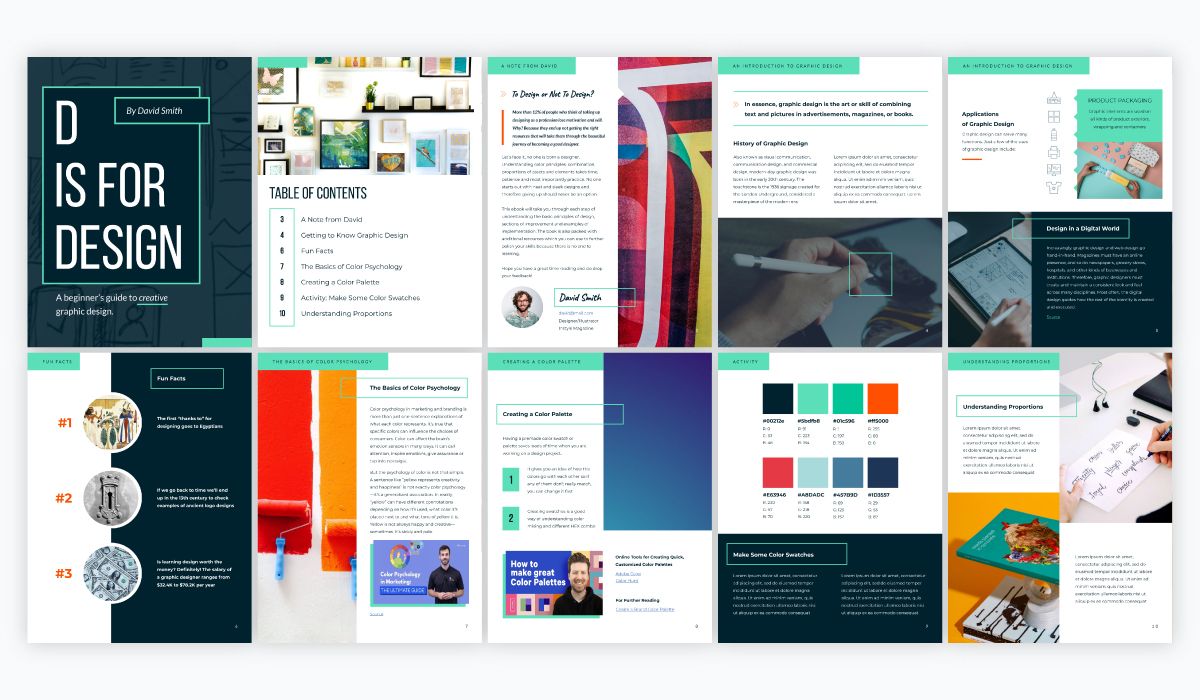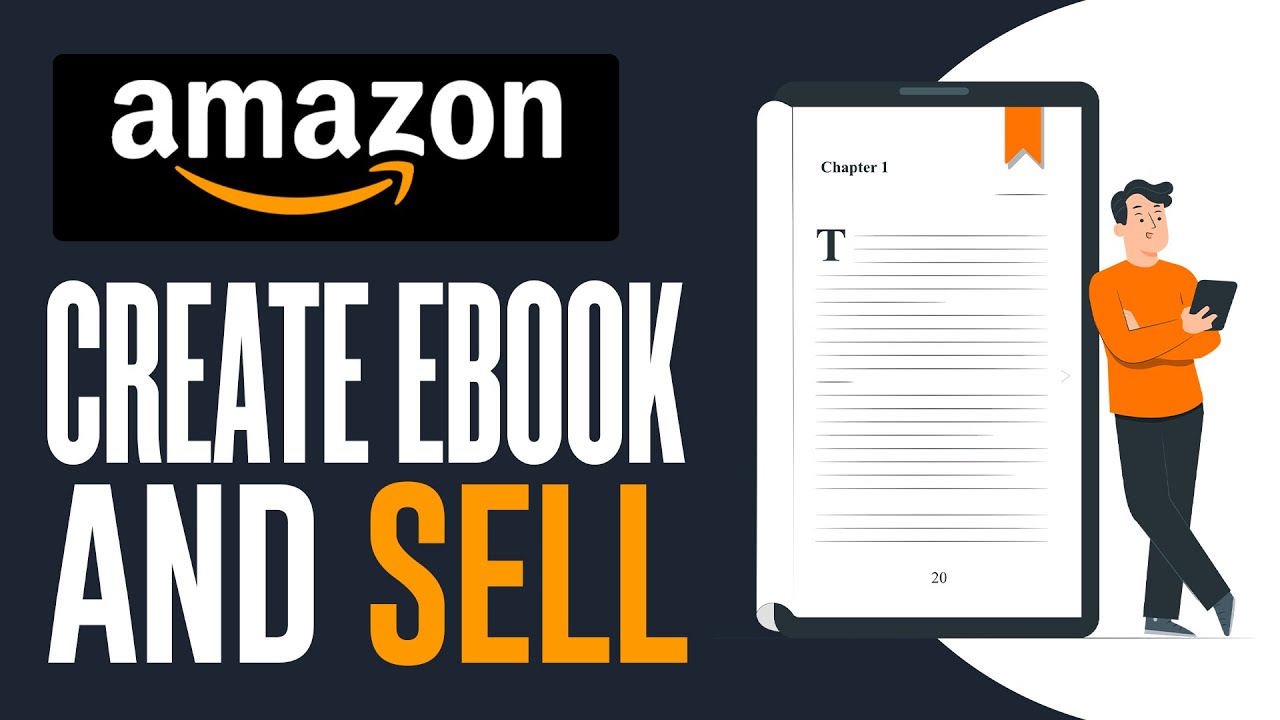Introduction
Welcome to the exciting world of eBook publishing! If you’ve written an eBook and are wondering how to sell it, you’ve come to the right place. Selling an eBook online has become increasingly popular, providing authors with a convenient and accessible way to share their work with a wide audience. Whether you’re a seasoned author or a first-time writer, this guide will walk you through the process of selling your eBook successfully.
With the growing popularity of e-readers and digital content, the demand for eBooks has skyrocketed. Selling your eBook allows you to reach readers from all around the world, without the need for traditional publishing methods. However, it’s important to approach eBook selling strategically to maximize your sales potential.
In this guide, we will explore various aspects of selling eBooks, including choosing the right platform, setting a competitive price, creating an appealing book cover, writing an attention-grabbing book description, formatting your eBook, and effectively marketing and promoting your work.
By following the tips and techniques outlined in this guide, you’ll be equipped with the knowledge and tools to create a successful eBook-selling strategy. Whether you’re an aspiring novelist, a business professional, or a hobbyist writer, learning how to effectively sell your eBook is an essential skill in today’s digital landscape.
Keep in mind that selling your eBook is not just about making money; it’s about connecting with readers and sharing your passion and knowledge with the world. So, roll up your sleeves and get ready to dive into the exciting journey of selling your eBook!
Choosing the Right Platform
When it comes to selling your eBook, choosing the right platform is crucial. The platform you select will determine the reach, visibility, and ease of selling your eBook. Here are some key factors to consider when choosing the right platform for your eBook:
- Marketplace Reach: Look for platforms that have a large user base and a wide reach. Popular eBook marketplaces like Amazon Kindle Direct Publishing (KDP), Barnes & Noble Nook Press, and Apple Books offer a massive potential audience for your eBook.
- Author Control: Consider the level of control you have over your eBook. Some platforms may restrict your ability to set prices, control promotions, or make changes to your eBook. Look for platforms that offer flexibility and allow you to retain control over your work.
- Royalty Rates: Pay close attention to the royalty rates offered by different platforms. Different platforms have varying royalty structures, so ensure you understand how much you will earn from each sale. Compare the rates and choose a platform that offers a fair and competitive royalty percentage.
- Ease of Use: Evaluate the platform’s user interface and ease of use. Look for platforms that have a user-friendly interface and provide clear instructions on how to upload and manage your eBook. This will save you time and make the publishing process smoother.
- Reporting and Analytics: Consider the availability of reporting and analytics tools. Being able to track your sales, monitor reader engagement, and analyze data is crucial for making informed decisions about your eBook marketing strategy. Look for platforms that provide comprehensive reporting and analytics features.
Remember, you don’t have to limit yourself to just one platform. Utilizing multiple platforms can broaden your reach and increase your sales potential. However, it’s essential to research each platform thoroughly and understand their respective terms and conditions.
Take the time to read reviews, join author communities, and seek feedback from other authors who have experience with different platforms. This will help you make an informed decision and choose the platform that aligns best with your goals and needs.
Once you’ve chosen the platform(s) for selling your eBook, it’s time to move on to the next steps in the eBook-selling journey.
Setting a Competitive Price
Setting the right price for your eBook is a crucial factor in attracting readers and maximizing your sales. It’s important to strike a balance between earning a profit and making your eBook accessible to potential buyers. Here are some key considerations when setting a competitive price for your eBook:
- Research the Market: Conduct market research to determine the average price range for eBooks in your genre or niche. Look at similar titles and analyze their pricing strategies. This will give you a benchmark to work with and help you understand the price expectations of potential readers.
- Consider the Value: Evaluate the value you’re providing to readers through your eBook. Factors such as the length, depth of content, uniqueness, and expertise offered can influence the perceived value of your eBook. If you’re delivering exceptional value, you may be able to justify a higher price.
- Target Audience: Understand your target audience and their purchasing power. Different demographics may have varying price sensitivity. If your eBook caters to a niche audience with specific needs or expertise, you may be able to set a higher price.
- Competitive Analysis: Analyze the pricing strategies of your competitors. Consider factors such as their reputation, sales rankings, and audience size. Pricing your eBook slightly lower than well-established competitors can entice readers to choose your book over others.
- Promotional Considerations: If you plan to offer promotions, discounts, or limited-time offers, factor them into your pricing strategy. Determine your regular price and assess the potential impact of promotional pricing on your overall sales and revenue.
Remember, pricing is not set in stone. You can adjust your price over time based on market feedback and performance. It’s worth experimenting with different price points to find the sweet spot that maximizes both your profit and reader satisfaction.
It’s also important to consider the royalty rates offered by the platform you are selling your eBook on. Keep in mind that higher pricing might result in a higher royalty percentage. Evaluate the pricing structure of the platform and make sure it aligns with your pricing strategy.
Ultimately, setting a competitive price involves finding the right balance between affordability for readers and fair compensation for your work. By carefully considering market trends, target audience, and the value of your eBook, you can determine a price that attracts readers and supports your eBook-selling goals.
Creating a Compelling Book Cover
They say not to judge a book by its cover, but when it comes to eBook sales, a compelling book cover plays a crucial role in catching the attention of potential readers. A visually appealing and professionally designed book cover can make all the difference in attracting buyers. Here are some tips to create a compelling book cover:
- Research and Inspiration: Start by researching successful eBook covers in your genre. Examine the design elements, color schemes, font choices, and imagery that resonate with readers and align with your book’s theme. Use these as inspiration to create your own unique and eye-catching cover.
- Professional Design: Unless you have graphic design experience, it’s best to invest in professional cover design. A well-designed cover can instantly elevate your eBook’s perceived quality and increase its appeal. Hire a professional book cover designer who can bring your vision to life and create a cover that stands out.
- Eye-Catching Imagery: Choose high-quality and relevant imagery that captures the essence of your book. Whether it’s an illustration, photograph, or a combination, ensure that it grabs attention and helps convey the genre or theme of your eBook at a glance.
- Typography: Select fonts that are legible and align with the genre and tone of your eBook. Experiment with different font styles, sizes, and placements to create a visually pleasing layout. Ensure that the title and author name are clear and prominent.
- Color Palette: Use a color palette that complements the mood and genre of your eBook. Consider the emotional impact that different colors can have. For example, warm colors like red and orange may evoke excitement, while cool colors like blue and green can create a sense of calmness or mystery.
- Simplicity and Clarity: Avoid cluttering your book cover with too many elements. Keep the design simple, with a clear focal point that draws the viewer’s attention. Remember that your cover will appear in small thumbnails online, so it should be easily recognizable and readable even in a smaller size.
Remember, your book cover is your first impression to potential readers, so it’s worth investing time and resources into creating a captivating design. A well-designed cover can entice readers to click, learn more about your eBook, and ultimately make a purchase.
Before finalizing your cover, consider conducting informal surveys or seeking feedback from your target audience or fellow authors. Their input can provide valuable insights and help you refine your design to create a compelling book cover that resonates with your readers.
Next, let’s explore how to write an attention-grabbing description to complement your visually appealing book cover.
Writing an Attention-Grabbing Description
Once you have created an eye-catching book cover, the next step is to captivate potential readers with an attention-grabbing book description. Your book description is like a sales pitch that entices readers to learn more and ultimately make a purchase. Here are some tips to write a compelling and engaging book description:
- Hook the Reader: Start your description with a strong hook that immediately grabs the reader’s attention. This can be a compelling question, a powerful statement, or an intriguing snippet from your eBook. The goal is to make readers curious and eager to know more.
- Highlight the Unique Selling Points: Showcase the unique aspects of your eBook that set it apart from others in your genre. Whether it’s a fresh perspective, a unique writing style, or an exciting plot twist, emphasize what makes your eBook stand out from the crowd.
- Focus on Benefits: Instead of just listing the features of your eBook, highlight the benefits that readers will gain by reading it. Will they be entertained, educated, inspired, or transported to another world? Clearly communicate the value and experience your eBook offers.
- Create Intrigue: Leave readers wanting more by hinting at the conflicts, mysteries, or surprises they’ll encounter in your eBook. Don’t give away all the details, but provide enough intrigue to make them curious and eager to dive into your story.
- Use Compelling Language: Opt for descriptive and vivid language that sparks the reader’s imagination. Paint a picture with your words and evoke emotions that resonate with your target audience. Craft your description to create excitement and anticipation for the reading experience.
- Include Testimonials or Reviews: If you have received positive feedback or reviews for your eBook, consider including a brief testimonial or snippet from a review. Social proof can help build trust and credibility, increasing the likelihood of a reader making a purchase.
- End with a Call to Action: Conclude your description with a clear call to action that encourages readers to take the next step, such as “Download now,” “Get your copy today,” or “Start reading now.” Make it easy for readers to know what to do next.
Remember, your book description is your opportunity to make a strong impression on potential readers. It should provide enough information to pique their interest and convince them that your eBook is worth their time and investment. Take the time to craft a compelling description that captivates and leaves readers eagerly reaching for their virtual shopping carts.
In the next section, we will explore the importance of properly formatting your eBook to ensure a seamless reading experience for your audience.
Formatting Your eBook
Formatting your eBook properly is essential for providing a seamless and enjoyable reading experience for your audience. A well-formatted eBook not only enhances readability but also conveys professionalism and attention to detail. Here are some key considerations for formatting your eBook:
- Consistent Formatting: Maintain consistency throughout your eBook by using the same font, font size, and line spacing. This ensures a uniform reading experience and prevents distractions for your readers.
- Chapter Breaks and Headings: Clearly indicate chapter breaks by adding page breaks and utilizing distinct heading styles. This allows readers to navigate easily through your eBook and find specific sections.
- Images and Graphics: If your eBook includes images or graphics, ensure they are properly formatted and optimized for the eBook platform. Adjust the size, resolution, and compression to maintain image quality without increasing the file size excessively.
- Consistent Margins: Set consistent margins for your eBook to provide an aesthetically pleasing reading experience. Avoid narrow or excessively wide margins that can make reading difficult on different devices or screen sizes.
- Paragraph Formatting: Use indentation or line spacing to clearly distinguish between paragraphs. This improves readability and makes it easier for readers to follow along.
- Hyperlinks and Navigation: If your eBook contains hyperlinks or references to external sources, make sure they are active and properly formatted. Additionally, create a clickable table of contents to help readers navigate your eBook effortlessly.
- Proofreading and Editing: Before publishing your eBook, thoroughly proofread and edit the content to ensure there are no typos, grammatical errors, or formatting inconsistencies. Mistakes can detract from the professionalism of your eBook and negatively impact the reading experience.
- Format for Different Devices: Consider the different eBook reading devices and formats that your audience may use. Ensure your eBook is compatible with popular platforms such as Kindle, Nook, or iPad. Test your eBook on different devices to ensure that the formatting translates well across various platforms.
Remember, eBook readers have different preferences and reading devices, so it’s important to create a versatile and well-formatted eBook that caters to their needs. Take the time to carefully format your eBook or consider hiring a professional formatter to ensure a polished final product.
Now that you’ve learned about formatting your eBook, it’s time to explore the process of uploading your eBook to the chosen platform.
Uploading Your eBook
Once you have meticulously formatted and finalized your eBook, it’s time to upload it to the platform(s) you have chosen. The process may vary depending on the platform, but here are some general steps to consider when uploading your eBook:
- Create an Account: If you haven’t already, create an account on the platform where you will be selling your eBook. Provide the necessary information and follow the platform’s registration process.
- Prepare Your eBook Files: Ensure that your eBook files are in the required format (e.g., EPUB, MOBI) as specified by the platform. Double-check that your eBook is properly formatted and free of any errors or issues.
- Add Metadata: Fill in the metadata for your eBook, including the title, author name, description, keywords, and categories. This information helps readers discover and understand your eBook better.
- Set Pricing and Royalties: Determine the price for your eBook and select the royalty options provided by the platform. Consider any promotional or discount strategies you may want to implement and configure them accordingly.
- Upload Your eBook: Follow the platform’s instructions to upload your eBook files. Ensure that you select the correct file format and upload the finalized version of your eBook.
- Preview and Test: Take advantage of the platform’s preview feature to review how your eBook will appear to readers. Test the functionality and navigation to ensure a seamless reading experience.
- Confirm and Publish: Once you are satisfied with the preview and have reviewed all the details, confirm your settings and hit the publish or submit button to make your eBook available for sale.
- Check Distribution: Depending on the platform, it may take some time for your eBook to be available across all channels. Monitor the distribution status and make sure it is live on the desired marketplaces.
It’s important to note that the uploading process may differ between platforms, so it’s essential to consult the platform’s documentation or support resources for specific instructions. Additionally, ensure that you comply with any requirements or guidelines outlined by the platform regarding file size, cover specifications, or content restrictions.
Once your eBook is live, it’s time to focus on marketing and promoting your eBook to reach your target audience. In the next section, we will explore effective strategies for marketing and promoting your eBook.
Marketing and Promoting Your eBook
Marketing and promotion play a crucial role in gaining visibility and driving sales for your eBook. Here are some effective strategies to market and promote your eBook to maximize its reach and attract potential readers:
- Build an Online Presence: Create a professional website or author blog to showcase your eBook and engage with your target audience. Optimize your website for search engines and regularly update it with valuable content related to your eBook’s topic.
- Utilize Social Media: Leverage popular social media platforms to connect with your audience, share updates about your eBook, and provide valuable content. Engage with followers, join relevant groups or communities, and run targeted ads to increase visibility.
- Collaborate with Influencers: Identify influencers in your niche who have a significant following and engage with their audience. Explore collaboration opportunities such as guest blogging, interviews, or joint promotions to expand your reach to a wider audience.
- Utilize Email Marketing: Build an email list of interested readers and potential buyers. Send regular newsletters with updates, exclusive content, and promotional offers to nurture your relationship with subscribers and encourage eBook sales.
- Engage with Your Readers: Interact with your readers through blog comments, social media, or email. Respond to their questions, comments, and reviews to build a loyal fanbase and foster a sense of connection and engagement.
- Encourage Reviews and Feedback: Positive reviews and ratings can significantly impact eBook sales. Encourage your readers to leave honest reviews and ratings on platforms like Amazon and Goodreads. Offer incentives such as bonus content or exclusive access to readers who leave reviews.
- Utilize Online Advertising: Consider running targeted online ads to reach a wider audience. Platforms like Google Ads and social media advertising allow you to promote your eBook to specific demographics and interest groups, maximizing the chances of reaching potential readers.
- Monitor Sales and Analytics: Regularly monitor your eBook sales performance and analyze the data provided by the platform. This will help you understand the effectiveness of your marketing efforts and make informed decisions to optimize your strategy.
Remember, effective marketing and promotion require consistency, patience, and persistence. Experiment with different strategies and track the results to identify what works best for your eBook and target audience. Building a strong author brand and connecting with your readers can lead to increased visibility and sustained sales over time.
In the next section, we will explore the importance of building an online presence and how it can further boost your eBook sales.
Building an Online Presence
Building an online presence is a crucial aspect of successfully promoting and selling your eBook. It allows you to connect with your target audience, establish credibility, and expand your reach. Here are some key strategies for building an effective online presence:
- Create a Professional Website: Set up a professional website or author blog that serves as a central hub for your eBook and related content. Design an attractive and user-friendly website that showcases your eBook, provides information about you as an author, and offers valuable resources for your readers.
- Optimize for Search Engines: Implement search engine optimization (SEO) strategies to improve your website’s visibility and ranking on search engines. Research relevant keywords, optimize your content, and build authoritative backlinks to increase organic traffic to your website.
- Produce Quality Content: Regularly publish high-quality content on your website or through guest blogging to establish yourself as an authority in your niche. Share valuable insights, tips, and resources related to your eBook’s topic to attract and engage your target audience.
- Engage with Your Audience: Actively engage with your audience through comments on your blog, social media platforms, and email newsletters. Respond to inquiries, address concerns, and build personal connections with your readers to foster trust and loyalty.
- Offer Freebies and Bonus Content: To incentivize readers to engage with your eBook and online presence, offer freebies or bonus content related to your eBook. This could include sample chapters, exclusive access to additional resources, or contests and giveaways that encourage readers to share and promote your eBook.
- Guest Blogging and Interviews: Seek opportunities to guest blog on websites relevant to your eBook’s topic or participate in podcast interviews. This helps you reach a wider audience and gain exposure, while also establishing yourself as a knowledgeable authority in your field.
- Build an Email List: Offer readers the option to subscribe to your email list through your website. Use email marketing to regularly connect with your audience, share updates about your eBook, provide exclusive content, and promote new releases or special offers.
- Participate in Online Communities: Get involved in relevant online communities, such as forums or social media groups, where your target audience gathers. Offer valuable insights, answer questions, and provide support to establish yourself as a trusted resource and draw attention to your eBook.
Building a strong and consistent online presence takes time and effort, but it can significantly impact your eBook sales and expand your reach. By providing valuable content, engaging with your audience, and utilizing various online channels, you can establish a brand presence that resonates with readers and encourages them to explore and purchase your eBook.
In the next section, we will delve into the power of social media and how it can enhance your eBook marketing efforts.
Utilizing Social Media
Social media platforms offer a powerful and cost-effective way to connect with your target audience, promote your eBook, and build a loyal following. By utilizing social media effectively, you can increase your online presence, drive engagement, and ultimately boost eBook sales. Here are some key strategies for utilizing social media:
- Choose the Right Platforms: Identify the social media platforms that align with your target audience and eBook genre. Popular options include Facebook, Twitter, Instagram, LinkedIn, Pinterest, and YouTube. Select platforms where your audience is most active and tailor your content accordingly.
- Create a Branded Profile: Optimize your social media profiles to reflect your author brand and eBook. Use consistent branding elements such as your author photo, eBook cover, and a compelling bio that showcases your expertise and showcases your eBook’s value.
- Share Engaging Content: Regularly post engaging and relevant content that provides value to your audience. This can include snippets from your eBook, writing tips and advice, behind-the-scenes insights, book recommendations, or content related to your eBook’s genre or topic.
- Engage with Your Audience: Actively engage with your followers by responding to comments, questions, and messages. Foster conversations, show appreciation for their support, and create a sense of community around your eBook and brand.
- Utilize Visual Content: Make use of visual content such as engaging graphics, images, and videos to capture attention and stand out in social media feeds. Visuals can help convey your eBook’s theme and entice readers to learn more.
- Run Contests and Giveaways: Organize contests or giveaways on social media to generate buzz and attract new followers. Encourage participants to share your eBook or social media posts to expand your reach and increase visibility.
- Collaborate with Influencers: Identify influencers or authors in your niche who have a significant following. Collaborate with them by hosting joint giveaways, participating in guest posts or interviews, or cross-promoting each other’s eBooks. This can help expand your reach and tap into new audiences.
- Utilize Social Media Advertising: Consider running targeted ad campaigns on social media to reach a wider audience. Platforms like Facebook Ads, Instagram Ads, and Twitter Ads allow you to define specific demographics, interests, and behaviors for optimal targeting of potential readers.
- Track and Analyze Results: Regularly monitor the performance of your social media efforts using analytics tools provided by each platform. Evaluate engagement metrics, demographics, and click-through rates to understand what type of content resonates best with your audience.
Remember, building a strong presence on social media takes time and consistency. Experiment with different content types, posting schedules, and engagement strategies to find what works best for your eBook and target audience. The key is to provide value, foster connections, and actively interact with your followers to build a loyal community of readers who are excited about your eBook.
In the next section, we will explore the benefits of collaborating with influencers and how it can enhance your eBook marketing efforts.
Collaborating with Influencers
Collaborating with influencers can significantly enhance your eBook marketing efforts by tapping into their existing audience and leveraging their influence and credibility. Influencers have an established following and can help you reach a wider audience that may be interested in your eBook. Here are some key strategies for collaborating with influencers:
- Identify the Right Influencers: Research and identify influencers in your eBook’s genre or niche who have a significant and engaged following. Look for influencers who align with your target audience and have a genuine interest in your eBook’s topic.
- Engage and Build Relationships: Begin by engaging with influencers on social media by liking, commenting, and sharing their content. Build a relationship, show genuine interest, and provide value before reaching out for a potential collaboration.
- Guest Blogging and Interviews: Offer to write guest blog posts for influencers in your niche or participate in podcast interviews. This allows you to tap into their existing audience and showcase your expertise and eBook to a wider audience.
- Host Joint Giveaways: Collaborate with influencers to host joint giveaways where participants have a chance to win both your eBook and other related prizes. This can generate excitement, increase visibility, and attract new readers.
- Cross-Promote Each Other: Share each other’s content, eBooks, or promotional materials on social media to introduce your followers to the influencer and vice versa. This cross-promotion allows you to tap into each other’s followers and expand your reach.
- Write Testimonials or Reviews: If you have read and enjoyed an influencer’s eBook, offer to write a testimonial or review. This helps build rapport and goodwill, potentially leading to future collaboration opportunities.
- Sponsorship or Affiliate Programs: Explore opportunities for sponsorships or affiliate programs where influencers can promote your eBook to their audience in exchange for compensation or a commission on sales generated.
- Collaborate on Content Creation: Consider collaborating with influencers on content creation, such as co-authoring articles, creating videos, or hosting webinars. This allows you to tap into their expertise and reach while providing valuable content to your audience.
When approaching influencers, be genuine, personal, and respectful. Clearly communicate why you believe your eBook and collaboration would be beneficial for them and their audience. Remember, influencers receive numerous collaboration requests, so make your pitch personalized, thoughtful, and focused on the value you bring.
Collaborating with influencers can significantly boost your eBook’s visibility, credibility, and reach. By leveraging their existing audience and influence, you can tap into new readers who are interested in your eBook’s genre or topic.
In the next section, we will explore the benefits of utilizing email marketing and how it can help you connect with your readers on a more personal level.
Utilizing Email Marketing
Email marketing is a powerful tool for connecting with your readers on a more personal level and nurturing relationships that can lead to increased eBook sales. By utilizing email marketing effectively, you can engage with your audience, provide valuable content, and promote your eBook in a direct and targeted manner. Here are some key strategies for utilizing email marketing:
- Build an Email List: Create opportunities for readers to subscribe to your email list through your website, blog, social media, or other promotional channels. Offer incentives such as a free chapter, exclusive content, or a newsletter subscription to encourage sign-ups.
- Segment Your Email List: Divide your email list into different segments based on interests, engagement, or demographics. This allows you to tailor your email content and promotions to specific groups, ensuring relevance and increasing the chances of conversion.
- Nurture Your Subscribers: Provide value to your subscribers by sending regular newsletters with relevant and engaging content. This can include updates about your eBook, exclusive previews, author insights, writing tips, or curated book recommendations.
- Promote Your eBook: Use your email list to promote your eBook directly to interested readers. Announce new releases, limited-time promotions, or pre-order opportunities to generate excitement and drive sales. Offer exclusive discounts or bonuses to reward your loyal subscribers.
- Personalize Your Emails: Personalize your emails by addressing subscribers by their names and tailoring the content to their specific interests. Use automation tools to send triggered emails based on subscriber behavior, such as abandoned cart reminders or follow-ups after eBook purchases.
- Encourage Engagement: Encourage readers to engage with your emails by including calls to action, asking for feedback or reviews, or running contests exclusive to your email subscribers. Foster a sense of community and connection with your subscribers.
- Analyze and Iterate: Track email performance by analyzing open rates, click-through rates, and conversion rates. Use this data to iterate and improve your email marketing strategy. Experiment with different subject lines, content formats, and sending frequencies to find what resonates best with your audience.
- Respect Subscriber Privacy: Comply with privacy regulations such as GDPR or CAN-SPAM laws. Always provide an option for subscribers to unsubscribe or manage their preferences. Respect their privacy and only send emails that they have opted-in to receive.
Email marketing allows you to maintain a direct line of communication with your readers, build trust, and keep them informed about your eBook. It is a valuable tool for cultivating relationships and transforming potential readers into loyal fans and customers.
Remember to balance promotional emails with valuable content that engages and nurtures your subscribers. Providing genuine value will help strengthen the connection with your readers and increase the likelihood of eBook sales.
In the next section, we will explore the importance of engaging with your readers to foster loyalty and boost eBook sales.
Engaging with Your Readers
Engaging with your readers is a crucial aspect of cultivating loyal fans and boosting eBook sales. By actively interacting with your readers, you can build a sense of community, foster meaningful connections, and create a memorable reading experience. Here are some key strategies for engaging with your readers:
- Respond to Comments and Messages: Take the time to respond to comments on your blog, social media posts, or email. Acknowledging and addressing reader feedback shows that you value their input and encourages further interaction.
- Hold Q&A Sessions: Host Q&A sessions on social media platforms or through live video streaming. Give readers the opportunity to ask questions about your eBook, writing process, or other related topics. This interactive format helps you connect with your audience on a more personal level.
- Create a Book Club or Reader Group: Establish a book club or reader group where readers can discuss and engage with your eBook and other related books. Encourage discussions, share additional content, and host virtual events to foster a sense of belonging and community.
- Offer Exclusive Content or Sneak Peeks: Reward your loyal readers by providing exclusive content, such as bonus chapters, behind-the-scenes insights, or sneak peeks of upcoming projects. Making readers feel like insiders strengthens their connection with you and encourages them to continue supporting your work.
- Ask for Reader Feedback: Regularly seek feedback from your readers. Ask them to share their thoughts, reviews, or suggestions for future projects. Show that you value their opinion and use their feedback to improve your writing and eBook marketing strategies.
- Host Contests or Giveaways: Organize contests or giveaways that are tailored to your readers. This can involve asking them to submit artwork, stories related to your eBook, or any creative content that connects with your book’s theme. Engaging readers through interactive activities builds excitement and encourages participation.
- Attend Book Events and Conferences: Participate in book events, conferences, and author signings to meet your readers in person. Engage in conversations, sign books, and offer personalized experiences. This strengthens the bond with your readers and creates lasting memories.
- Show Appreciation: Regularly thank your readers for their support, whether in emails, social media posts, or dedicated acknowledgments in your eBooks. Expressing gratitude makes readers feel valued and reinforces their connection with you as an author.
Remember, genuine and authentic engagement is key. Show a sincere interest in your readers and their experiences with your eBook. Encourage conversations, listen to their opinions, and make them feel heard and appreciated.
Building a strong and engaged reader community not only leads to increased eBook sales but also creates a supportive and loyal following that can champion your work and help expand its reach.
In the next section, we will explore the benefits of encouraging reviews and feedback for your eBook.
Encouraging Reviews and Feedback
Encouraging reviews and feedback for your eBook is essential for building credibility, increasing visibility, and driving eBook sales. Positive reviews and ratings not only attract potential readers but also provide social proof of the quality and value of your eBook. Here are some strategies to encourage reviews and feedback:
- Ask for Reviews: Reach out to your readers and ask them to leave a review after they have read your eBook. Include a polite call-to-action in your eBook, website, social media posts, or email newsletters, encouraging them to share their thoughts and experiences.
- Offer Incentives: Provide incentives for readers to leave a review, such as offering exclusive content, bonus chapters, or entry into a giveaway. Offer appreciation to those who take the time to share their feedback.
- Create a Review Campaign: Launch a review campaign to generate buzz and engage your existing readers. Set a specific time frame and encourage readers to participate in leaving reviews during that period. Promote the campaign on your website, social media, and email newsletters to maximize participation.
- Engage with Reviews: Respond to reviews, both positive and negative, to engage with your readers and demonstrate your appreciation for their feedback. Address concerns, offer support, and thank them for taking the time to write a review. This shows that you value their opinions and are actively involved in the reader-writer exchange.
- Utilize Review Platforms: Encourage readers to leave reviews on popular platforms such as Amazon, Goodreads, or other book review websites. These platforms are often visited by potential readers seeking recommendations and can have a significant impact on eBook visibility.
- Offer Advanced Reader Copies (ARCs): Prior to your eBook’s release, distribute advanced reader copies to a select group of readers in exchange for honest reviews. ARCs not only generate buzz for your eBook but also provide valuable feedback that can help you make improvements before the public release.
- Utilize Email Marketing: Send dedicated emails to your subscribers requesting reviews, sharing positive reviews you’ve received, or highlighting the impact of reviews on your eBook’s success. In these emails, provide clear instructions on how and where readers can leave reviews.
- Share Reviews and Testimonials: Share positive reviews and testimonials on your website, social media, and promotional materials. Potential readers are more likely to trust recommendations from others, particularly if they can see that real readers have enjoyed and benefited from your eBook.
It’s important to note that while positive reviews are valuable, negative reviews can also provide insights for improvement. Embrace constructive criticism and use it to enhance your future writing and marketing endeavors.
Always respect readers’ opinions and appreciate their time and effort in leaving reviews. By actively encouraging and engaging with reviews and feedback, you can build credibility, attract potential readers, and create a loyal community of supporters who will continue to advocate for your work.
In the next section, we will explore the benefits of utilizing advertising to increase visibility and eBook sales.
Utilizing Online Advertising
Utilizing online advertising is a powerful strategy for increasing the visibility of your eBook, reaching a wider audience, and boosting eBook sales. Online advertising allows you to target specific demographics and interests to ensure your eBook reaches potential readers who are most likely to be interested in your genre or topic. Here are some strategies for effectively utilizing online advertising:
- Define Your Target Audience: Clearly define your target audience based on demographics, interests, and reading preferences. Understanding who your ideal readers are will help you create targeted and effective ad campaigns.
- Research Advertising Platforms: Familiarize yourself with different online advertising platforms such as Google Ads, Facebook Ads, Amazon Advertising, or other platforms that align with your marketing goals. Each platform has its own unique features and targeting options.
- Set a Budget: Determine a realistic advertising budget for your eBook marketing campaign. Experiment with different ad formats, placements, and targeting options to find the most cost-effective strategies that yield the best results.
- Create Compelling Ad Copy: Craft compelling ad copy that grabs attention and entices potential readers to click on your ad. Highlight the unique selling points of your eBook, include a clear call to action, and use persuasive language to spark curiosity and drive clicks.
- Design Eye-Catching Visuals: Create visually appealing and engaging ad visuals that stand out in a crowded digital space. Use high-quality images, captivating headlines, and vibrant colors to capture the attention of potential readers as they scroll through their feeds.
- Target Specific Keywords: Utilize keyword targeting to ensure your ads appear when users search for relevant keywords related to your eBook’s genre or topic. This can improve the visibility of your eBook in search engine results or on platforms like Amazon.
- Track and Optimize Performance: Regularly track the performance of your ad campaigns and analyze data provided by the advertising platforms. Monitor metrics such as click-through rates, conversion rates, and cost per acquisition. Use this information to optimize your campaigns for better results.
- Utilize Retargeting: Implement retargeting campaigns to reconnect with visitors who have shown interest in your eBook by visiting your website or engaged with your previous ads. This helps reinforce your brand and keeps your eBook top of mind for potential readers.
- Test and Iterate: Don’t be afraid to experiment and test different ad formats, targeting options, ad placements, and messaging. Continuously analyze the results and iterate your advertising strategy to improve performance and maximize your return on investment.
Online advertising can significantly increase your eBook’s visibility and reach, placing it in front of potential readers who may not have discovered it otherwise. With careful planning, audience targeting, and strategic optimization, you can effectively leverage online advertising to boost eBook sales and expand your reader base.
In the next section, we will explore the importance of monitoring sales and analytics to gain insights and make informed decisions to improve your eBook marketing strategy.
Monitoring Sales and Analytics
Monitoring sales and analytics is a crucial aspect of eBook marketing, as it provides valuable insights into your eBook’s performance and helps you make informed decisions to improve your marketing strategy. By monitoring sales and analytics, you can understand the effectiveness of your marketing efforts, identify trends, and make data-driven decisions to optimize your eBook’s success. Here are some key strategies for monitoring sales and analytics:
- Track Sales Performance: Keep a close eye on your eBook’s sales performance across different platforms and marketplaces. Monitor the number of units sold, revenue generated, and the overall trends in sales over time. This will help you gauge the effectiveness of your marketing efforts and measure the return on investment.
- Utilize Platform Analytics: Leverage the analytics tools provided by eBook selling platforms such as Amazon KDP, Barnes & Noble Nook Press, or Apple Books. These platforms often provide valuable data on sales, customer engagement, and audience demographics. Analyze this data to identify patterns and opportunities for improvement.
- Analyze Conversion Rates: Evaluate the conversion rates of your marketing campaigns to measure their effectiveness in driving eBook sales. Monitor the click-through rates of your ads, landing page conversion rates, and the percentage of visitors who ultimately make a purchase.
- Monitor Customer Reviews and Ratings: Pay attention to customer reviews and ratings on review platforms like Amazon or Goodreads. Analyze the feedback to understand reader preferences, identify areas for improvement, and make necessary adjustments to your eBook and marketing strategy.
- Track Website and Blog Analytics: Utilize web analytics tools like Google Analytics to monitor traffic to your website or author blog. Understand where your visitors are coming from, which pages they visit, and how much time they spend on your site. This will help you evaluate the effectiveness of your content and identify areas for improvement.
- Monitor Social Media Engagement: Keep a close eye on social media metrics such as likes, comments, shares, and engagement rates. Analyze the performance of your social media campaigns to determine which platforms and content types resonate best with your audience.
- Set Goals and Key Performance Indicators (KPIs): Establish clear goals and KPIs for your eBook marketing efforts. This could include targets for sales, engagement rates, conversion rates, or website traffic. Regularly assess your progress towards these goals and make adjustments to your strategies as needed.
- Compare and Analyze Marketing Campaigns: Compare the performance of different marketing campaigns to determine which strategies yield the greatest results. Assess the cost-effectiveness, reach, and conversion rates of each campaign to optimize your budget allocation and refine your future marketing efforts.
Analytics provide valuable insights into the behaviors and preferences of your readers, allowing you to make data-driven decisions to improve your eBook marketing strategy. Regularly monitor sales and analytics, and use the data to iterate, optimize, and refine your marketing efforts for maximum impact.
In the next section, we will explore the importance of making adjustments and improvements based on your monitoring and analytics insights.
Making Adjustments and Improvements
Regularly making adjustments and improvements based on the insights gathered from monitoring sales and analytics is key to optimizing your eBook marketing efforts and maximizing its success. By analyzing the data and feedback received, you can identify areas for improvement and make informed decisions to enhance your eBook and marketing strategies. Here are some key considerations for making adjustments and improvements:
- Evaluate Marketing Campaigns: Review the performance of your marketing campaigns, including online advertising, social media promotions, and email marketing. Identify campaigns that generated the best results and those that fell short. Adjust your strategies and allocate resources to the most effective channels.
- Optimize Your eBook: Analyze feedback from readers, paying attention to reviews, ratings, and comments. Identify any common themes or issues raised and determine if adjustments can be made to enhance the reader experience. This could involve revising content, refining the eBook’s structure, or improving formatting and layout.
- Refine Targeting and Segmentation: Evaluate the effectiveness of your target audience and segmentation strategies. Assess whether you are effectively reaching the intended readers and consider refining your approach. Modify your messaging, ad targeting, and content to better align with the preferences and needs of your target audience.
- Experiment with Pricing and Promotions: Adjust the pricing of your eBook based on the insights gained from monitoring sales and competitor analysis. Consider running limited-time promotions, discounts, or bundling offers to incentivize readers and drive sales. Track the impact of these adjustments on sales and revenue.
- Refine Your Website and Online Presence: Analyze website and online presence analytics to identify areas that can be improved. Assess user experience, page load times, and mobile responsiveness. Make adjustments to ensure a seamless and enjoyable user journey, enhancing visitor engagement and conversion rates.
- Engage with Your Audience: Continually engage with your readers through comments, emails, social media, and events. Foster relationships, address concerns, and seek feedback to understand their preferences. Use these insights to tailor your marketing efforts and make improvements that cater to your readers’ needs.
- Monitor Industry and Market Trends: Stay abreast of industry and market trends to ensure your eBook remains relevant and competitive. Analyze the performance of similar eBooks in your genre and identify emerging trends or changing reader preferences. Adjust your strategies accordingly and explore new opportunities that align with these trends.
- Continuously Learn and Adapt: Remain open to learning and adapting to the evolving landscape of eBook publishing and marketing. Stay curious, explore new techniques, and embrace emerging technologies to innovate and stay ahead of the competition. Regularly assess the performance of your eBook and marketing efforts and iterate as needed.
Remember, making adjustments and improvements is an ongoing process. Embrace a growth mindset and be willing to adapt based on the data and insights you receive. Experiment with different strategies to determine what works best in reaching and engaging your target audience.
By monitoring, analyzing, and taking action based on the feedback and data, you can continually optimize your eBook marketing efforts and ensure its success in the ever-evolving digital landscape.
Up next, we will conclude our guide by summarizing the key takeaways and emphasizing the importance of implementing a comprehensive marketing strategy for your eBook.
Conclusion
Congratulations on reaching the end of this comprehensive guide on how to effectively market and sell your eBook! Throughout this journey, we’ve explored various strategies and tactics to maximize your eBook’s visibility, engage with readers, and drive sales. Let’s recap the key takeaways:
First and foremost, choosing the right platform is crucial. Consider the marketplace reach, author control, royalty rates, ease of use, and reporting options when selecting the platform(s) to sell your eBook.
Setting a competitive price involves researching the market, considering the value of your eBook, understanding your target audience, analyzing competition, and factoring in promotional considerations.
Crafting a compelling book cover is essential to grab readers’ attention. Invest in professional design, choose eye-catching imagery, use appropriate fonts, and create an aesthetically pleasing layout.
Writing an attention-grabbing book description is crucial to entice readers. Hook them with a strong opening, highlight unique selling points, focus on benefits, create intrigue, and end with a clear call to action.
Properly formatting your eBook ensures a seamless reading experience. Maintain consistent formatting, utilize chapter breaks and headings, optimize images and graphics, and create visually appealing layouts.
Uploading your eBook involves creating an account on the chosen platform, preparing and uploading your eBook files, adding metadata, setting pricing and royalties, previewing and testing, and finally publishing your eBook.
Marketing and promoting your eBook is key to increasing its visibility and sales. Build an online presence through a professional website, utilize social media, collaborate with influencers, utilize email marketing, engage with readers, encourage reviews and feedback, and utilize online advertising.
Monitoring sales and analytics provides valuable insights for making data-driven decisions. Track sales performance, leverage platform analytics, analyze conversion rates, monitor reviews and ratings, track website and blog analytics, monitor social media engagement, and set goals and KPIs.
Making adjustments and improvements is an ongoing process. Evaluate marketing campaigns, optimize your eBook, refine targeting and segmentation, experiment with pricing and promotions, refine your online presence, engage with your audience, monitor industry trends, and continuously learn and adapt.
Remember, each step of the process requires dedication, consistency, and a deep understanding of your target audience. By implementing a comprehensive marketing strategy and utilizing the strategies outlined in this guide, you are well on your way to successfully selling your eBook and reaching a wider audience.
Now, armed with this knowledge and these strategies, it’s time to put your plan into action. Harness your creativity, adapt to changing trends, engage with your readers, and continuously improve your eBook marketing efforts. May your eBook flourish and connect with readers all around the world!

























